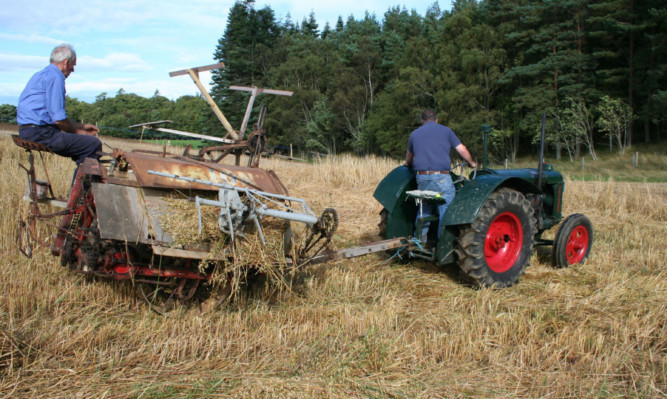Albion reapers, binders, mowers, rakes, seed drills, potato planters and diggers and barn machinery had worked on Britain’s farms ever since the 19th Century, the firm having been founded by Henry Harrison, Alexander McGregor and George Rich in 1872.
Mowers were the first implements produced before the range broadened out.
By 1914 some 1,000 people were employed at its manufacturing site at Albion Street in Leigh in Lancashire.
Albion was adopted as the trademark name and was also used by David Brown when it took over.
Success at home and abroad led the business to win many awards for implement design.
Tractor implements were added between the wars, but the range had to be streamlined as the hostilities had severely dented exports.
More emphasis was placed on hay-making machinery and binders, and less on barn machinery as new compound feeds available from merchants reduced the need for farms to process and mix their own livestock rations.
The Second World War saw the firm’s fortunes pick up from the depression years as Britain had to grow more food of its own.
Albion had produced a fine range of binders and was instructed to put much of its capacity into manufacturing these machines. Producing 3,800 units a year, it was Britain’s largest binder manufacturer and, along with Bisset of Blairgowrie, probably the only UK producers of these machines, which were also imported from several US concerns through Lend Lease.
After the war the company wished to get back to a varied list but needed capital to broaden production in what was an elderly plant producing old designs.
That injection came from Oscar Guest, who joined the firm in 1946, causing a name change to Harrison McGregor & Guest.
Although still popular the implement designs were dated, using heavy castings. Indeed, the range of binders were deemed too heavy to pull on hilly or soft land.
Albion colour schemes tended to be red and creamy yellow, although blue and green have also been used and some binders were turned out in harvest gold.
The post-war period saw Albion try to move into non-agricultural products, manufacturing printing presses at a plant in Wales. This operation was not a success.
Meanwhile David Brown had done well through government contracts during the war, and the post-war Cropmaster tractor sold very well, so funds were available.
The sales department pressured management and engineering to offer more implements, and even a combine, as the opposition offered full ranges.
Engineering pointed out the cost and timescale of developing products, so management, at the behest of David Brown himself, looked for a suitable firm to buy that would offer that all-important full line.
Albion had been working on a combine prototype which was a very small trailed affair aimed at the small farmer still using a binder. The Lancashire concern was thus appealing to the firm from Yorkshire.
In early 1955 David Brown bought Harrison McGregor & Guest and its Albion plant in Leigh.
The purchase led to the firm adopting a new logo. The old image of a wheeled and crawler tractor in front of a globe gave way to a logo shaped like a shield with the initials DB in two diagonally opposite corners, with the red rose of Lancashire in one other and the white rose of Yorkshire in the other, indicating two manufacturing plants in two counties.
DB Tractors also had another production facility, at Farsley near Leeds.
When chief engineer Herbert Ashfield visited the factory at Leigh for the first time he noted ageing machine tools, an ageing workforce, and a haphazard method of production, costing and service and parts regimes.
There were also huge stocks of binders and mowers lying everywhere.
The necessary modernisation was sensitively done. David Brown gradually repaired the buildings, and heavy discounts were offered to clear the unsold stock.
More modern implement production at the tractor plant at Meltham near Huddersfield or Farsley was transferred to Leigh to give the workforce jobs, while the over-65s were given small pensions and retired.
New machine tools and welders were installed, and production methods started to involve fabricated assemblies rather than cast parts.
During this period David Brown offered a large range including mounted ploughs, cultivators, ridgers, potato planters, spinner diggers, beet ploughs, hay mowers, hay turners and buck rakes. Other implements included saw benches, hammer mills, harrows, winches, the Turbo Tiller and a trailer.
Albion’s binder was also produced for a while after the takeover.
Albion’s combine was too far down the line of development to make an impact, so there was an agreement to build the Swedish Arvika combine.
David Brown was clever enough to continue to use the Albion name on its implements and machines such as the dung spreader, the famous DB Albion sideways pick-up baler and the revolutionary Hurricane forage harvester, which all carried a large Albion decal in black and white.
But as farm machinery developed through the 1960s the designs became more complex and required specialist engineering which even larger full-line concerns had trouble keeping up with.
By the end of the 1960s DB had dropped all the implements except for ploughs, fore-end loaders and back actors.
In the 1970s plough manufacture was dropped, freeing up more production capacity for tractor components and David Brown’s own line of safety cabs.
The introduction of the 90 series tractors in 1979 saw Sekura cabs used, but Leigh was still busy producing many other components.
David Brown’s owner Tenneco, which also owned JI Case, stepped in to buy the ailing International Harvester Company in late 1984. This led to a major rationalisation of products and production sites.
David Brown products had been branded as Case products in 1983, but future Case IH models were to be built at Doncaster meaning the closure of Meltham and therefore Leigh in 1988.
Sadly the factory in Albion Street in Leigh was demolished and redeveloped, ending a proud history in farm equipment manufacture.
